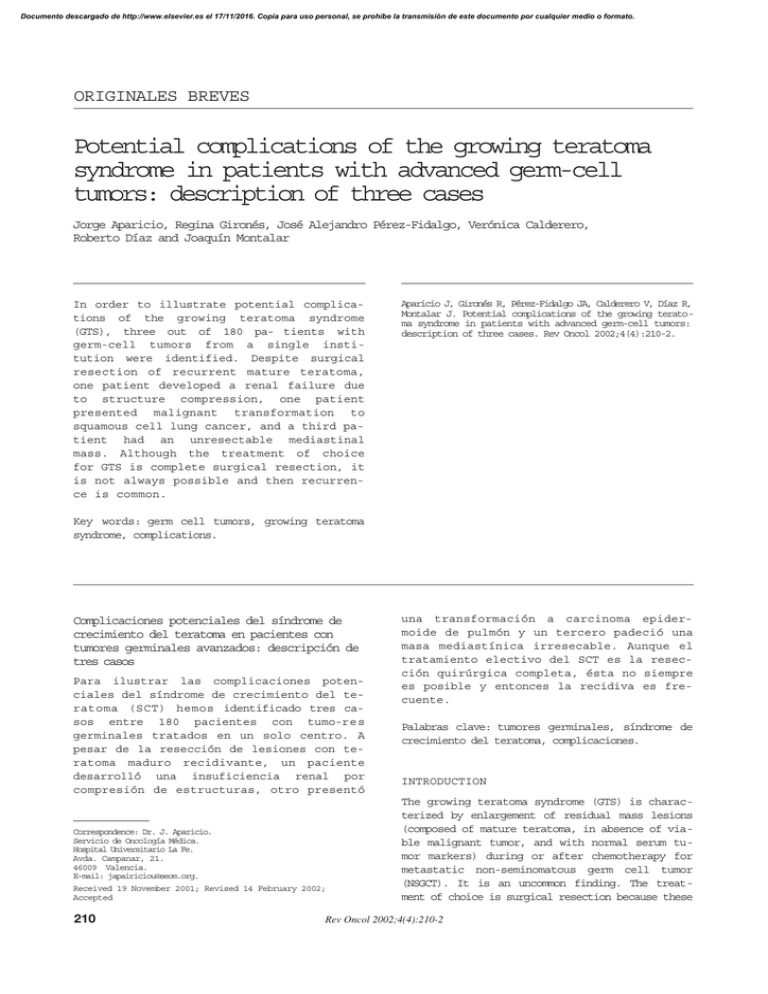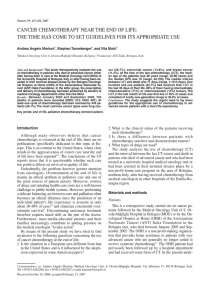Potential complications of the growing teratoma syndrome in
Anuncio

Documento descargado de http://www.elsevier.es el 17/11/2016. Copia para uso personal, se prohíbe la transmisión de este documento por cualquier medio o formato. ORIGINALES BREVES Potential complications of the growing teratoma syndrome in patients with advanced germ-cell tumors: description of three cases Jorge Aparicio, Regina Gironés, José Alejandro Pérez-Fidalgo, Verónica Calderero, Roberto Díaz and Joaquín Montalar In order to illustrate potential complications of the growing teratoma syndrome (GTS), three out of 180 pa- tients with germ-cell tumors from a single institution were identified. Despite surgical resection of recurrent mature teratoma, one patient developed a renal failure due to structure compression, one patient presented malignant transformation to squamous cell lung cancer, and a third patient had an unresectable mediastinal mass. Although the treatment of choice for GTS is complete surgical resection, it is not always possible and then recurrence is common. Aparicio J, Gironés R, Pérez-Fidalgo JA, Calderero V, Díaz R, Montalar J. Potential complications of the growing teratoma syndrome in patients with advanced germ-cell tumors: description of three cases. Rev Oncol 2002;4(4):210-2. Key words: germ cell tumors, growing teratoma syndrome, complications. Complicaciones potenciales del síndrome de crecimiento del teratoma en pacientes con tumores germinales avanzados: descripción de tres casos Para ilustrar las complicaciones potenciales del síndrome de crecimiento del teratoma (SCT) hemos identificado tres casos entre 180 pacientes con tumo-res germinales tratados en un solo centro. A pesar de la resección de lesiones con teratoma maduro recidivante, un paciente desarrolló una insuficiencia renal por compresión de estructuras, otro presentó Correspondence: Dr. J. Aparicio. Servicio de Oncología Médica. Hospital Universitario La Fe. Avda. Campanar, 21. 46009 Valencia. E-mail: [email protected]. Received 19 November 2001; Revised 14 February 2002; Accepted 210 una transformación a carcinoma epidermoide de pulmón y un tercero padeció una masa mediastínica irresecable. Aunque el tratamiento electivo del SCT es la resección quirúrgica completa, ésta no siempre es posible y entonces la recidiva es frecuente. Palabras clave: tumores germinales, síndrome de crecimiento del teratoma, complicaciones. INTRODUCTION The growing teratoma syndrome (GTS) is characterized by enlargement of residual mass lesions (composed of mature teratoma, in absence of viable malignant tumor, and with normal serum tumor markers) during or after chemotherapy for metastatic non-seminomatous germ cell tumor (NSGCT). It is an uncommon finding. The treatment of choice is surgical resection because these Rev Oncol 2002;4(4):210-2 Documento descargado de http://www.elsevier.es el 17/11/2016. Copia para uso personal, se prohíbe la transmisión de este documento por cualquier medio o formato. APARICIO J, GIRONÉS R, PÉREZ-FIDALGO JA, ET AL. POTENTIAL COMPLICATIONS OF THE GROWING TERATOMA SYNDROME IN PATIENTS WITH ADVANCED GERM-CELL TUMORS: DESCRIPTION OF THREE CASES lesions do not respond to chemotherapy. If a complete excision is not possible, several complications may occur due to compression of neurovascular or visceral structures (mainly retroperitoneal and mediastinal), malignant transformation, or even may be responsible for the development of late relapses and distant me1,2 tastases . Between 1975 and 2000, 180 patients with testicular and extragonadal germ cell tumors have been treated in our department; we have identified three cases with unresectable or recurrent lesions that exemplify the evolutionary spectrum of the GTS. dose carboplatin, etoposide and cyclophosphamide with autologous stem cell rescue in May 1996). A second partial response was achieved (negative markers, unresectable residual mass). In January 1997, a new marker increase was detected (AFP 7368 ng/ml, BHCG 3475 UI/l), and he received oral chemotherapy with low-dose continuous etoposide; in spite of a good marker decline curve, the patient was admitted to hospital 3 months later with an episode of oliguria and back pain. The abdominal mass had notably grown (fig. 1), thus producing a right hydronephrosis, absence of renal arterial perfusion (detected by radionuclide scans) and an acute renal failure (serum creatinine, 9 mg/dl). He did not respond to fluids, dopamine and hemodialysis, and died a few days later. CASE REPORTS Case 1 Case 2 A 25 year-old man was diagnosed in October 1993 of a right testicular, mixed histology NSGCT (embryonal carcinoma, mature teratoma, and choriocarcinoma), staged IV-C-L3 according 3 to Royal Marsden´s classification . Retrospectively revised, he fulfilled intermediate IGCCCG 4 prognosis criteria (alpha-fetoprotein, AFP 4,800 ng/ml; beta-human chorionic gonadotropin, BHCG 32,600 UI/l). An inguinal orchiectomy was performed, and he received 8 courses of alternating 5 chemotherapy BOMP/EPI , thus attaining a partial response (negative markers, persistence of a cystic retroperitoneal mass, and absence of distant metastases). The residual mass encompassed the great vessels and the right ureter, and was therefore deemed unresectable. By July 1995 the patient presented a retroperitoneal and supraclavicular node relapse with raised serum markers (AFP 331 ng/ml), and received salvage chemotherapy with several sequential schemes (ACE/PEV, VeIP, paclitaxel and, finally, high- A 22 year-old male was diagnosed in November 1984 of a testicular teratocarcinoma, Royal Marsden stage IV-B-L3 with intermediate IGCCCG criteria. He received a left orchiectomy and systemic chemotherapy with 4 cycles of PVB (cisplatin, vinblastine and bleo-mycin); a partial response was achieved (persistence of lung nodules with negative serum markers). A right thoracotomy was performed with resection of 2 nodules. Their histologic analysis revealed mature teratoma. A few contralateral micronodules were left and carefully watched. Five years later, one of them grew and was resected, the diagnosis being again mature teratoma. In November 1994 he suffered a late retroperitoneal relapse with increased serum markers (AFP 197 ng/ml) and received salvage chemotherapy with 4 courses of BOMP/EPI and a retroperitoneal resection again revealing mature teratoma without malignant elements. Fig. 1. CT scan of the abdomen. Large cystic masses involving the great vessels. Fig. 2. CT scan of the thorax. Parahillar lung nodule with malignant transformation. Rev Oncol 2002;4(4):210-2 211 Documento descargado de http://www.elsevier.es el 17/11/2016. Copia para uso personal, se prohíbe la transmisión de este documento por cualquier medio o formato. APARICIO J, GIRONÉS R, PÉREZ-FIDALGO JA, ET AL. POTENTIAL COMPLICATIONS OF THE GROWING TERATOMA SYNDROME IN PATIENTS WITH ADVANCED GERM-CELL TUMORS: DESCRIPTION OF THREE CASES Today, the patient lives without sequelae, but his mediastinal lesions are slowly growing (fig. 3); there are no signs of neurovascular injure, and a wait-and-watch policy has been decided. DISCUSSION Fig. 3. CT scan of the thorax. Slowly-growing, mediastinal cystic mass. By June 1998 a progressive growth of a preexisting parahillar lung nodule was noted (fig. 2), in the absence of symptoms and with a discrete elevation of AFP (53 ng/ml). A fiberoptic bronchoscopy and transbronchial biopsy was diagnostic of squamous cell lung cancer, that was deemed unresectable. He received chemotherapy (carboplatin plus paclitaxel) and thoracic irradiation (55 Gy), but 6 months later developed brain metastases and died shortly thereafter (about 15 years after the initial diagnosis). Case 3 A 20 year-old man presented an extragonadal retroperitoneal, mixed histology (immature teratoma plus embryonal carcinoma) NSGCT in June 1985. Distant (hepatic, pulmonary, supraclavicular and mediastinal lymph node) metastases were present, with (today´s) IGCCCG poor prognostic criteria. AFP was 5,000 ng/ml and BHCG was 446 mU/ml. He received 6 courses of alternating BEP/PVB chemotherapy, and attained a complete biological response (negative serum markers) with residual lesions in retroperitoneum and posterior mediastinum. Both of them were surgically resected in a combined intervention in December 1985. The histologic exam revealed mature teratoma, with fibrous and necrosis elements. Since then, the patient has persisted disease-free and with negative markers. However, in subsequent CT scans, several small cystic lesions were visible next to the great vessels at the mediastinum. In April 1994, one of these lesions grew producing irradiated back pain, and was again resected. The surgical procedure was incomplete because of vascular involvement. The histology was mature teratoma once more. 212 Testicular cancer has become the model of a curable neoplasm. After the recognition of the ability of cisplatin-containing combination chemotherapy to successfully treat advanced disease, more than 90 percent of patients with newly diagnosed germ-cell tumors are likely to be cured of their disease. Surgical resection of residual disease is necessary in patients with NSGCT who have normal serum tumor markers after chemotherapy. About 45 percent of these masses display necrotic debris or fibrosis on pathological examination, 40 percent have evidence of mature teratoma, and 15 percent show viable malignant cells. Only in the last case further therapy is required, and two additional chemotherapy courses are re6 commended to maximize the cure rate . Enlargement of tumor masses in the context of declining or normal tumor markers values (during of shortly after chemotherapy) generally represents a unique entity, the so-called GTS, and also requires surgical resection. Since the original description of this syndrome, multiple case reports have been published but only a few clinical series with an adequate methodology of study ha1,2,7-10 ve been reported . Some conclusions may be drawn from these studies: a) the GTS is uncommon, occurring in 2 to 8 percent of metastatic NSGCT (i.e., seminomas are excluded), including testicular, ovarian and extragonadal primaries; b) involved sites are only locations previously affected by the disease, mainly retroperitoneum and chest, but have also been described at mediastinum, cervical lymph nodes, forearm, and pineal gland; c) the appearance of cysts in the growing masses, detected at computed tomography scan, is characteristic; d) the presence of mature teratoma in any or both the primary tumor and its postchemotherapy residual masses is associated with an increased risk of GTS; e) tumor masses do not respond to either chemotherapy or radiotherapy, and only partial respon11 ses to interferon have been described ; f) surgical resection is the treatment of choice. It confirms the absence of malignant histology, prevents local complications, and avoids malignant transformation or dissemination; however, complete resection is not always possible, and g) recurrences are frequent, usually in the form of mature teratoma, but also may content malignant Rev Oncol 2002;4(4):210-2 Documento descargado de http://www.elsevier.es el 17/11/2016. Copia para uso personal, se prohíbe la transmisión de este documento por cualquier medio o formato. APARICIO J, GIRONÉS R, PÉREZ-FIDALGO JA, ET AL. POTENTIAL COMPLICATIONS OF THE GROWING TERATOMA SYNDROME IN PATIENTS WITH ADVANCED GERM-CELL TUMORS: DESCRIPTION OF THEREE CASES germ-cell (producing mainly serum AFP) and non germ-cell elements. The cases presented here (and their images) are representative of these potential complications of the GTS. Despite its low incidence, it should be stressed the importance of a complete (repetitive if necessary) resection of residual masses and a prolonged follow-up of these patients. Case 2 is unique because the transformation of mature teratoma into squamous cell carcinoma is exceptional; however, a casual aggregation of two independent malignancies can not be definitively ruled out. References 1. Logothetis CJ, Samuels ML, Trindade A, et al. The growing teratoma syndrome. Cancer 1982;50:1629-35. 2. Jeffery GM, Theaker JM, Lee AHS, et al. The growing teratoma syndrome. Br J Urol 1991;67:195-202. 3. Medical Research Council Working Party on Testicular Tumours. Prognostic factors in advanced non-seminomatous germ-cell testicular tumours: results of a multicentre study. Lancet 1985;i:8-11. 4. International Germ Cell Cancer Collaborative Group (IGCCCG). International Germ Cell Consensus Classification: a prognostic factor-based staging system for metastatic germ cell cancers. J Clin Oncol 1997;15:594-603. 5. Germà-Lluch JR, García del Muro X, Tabernero JM, et al. BOMP-EPI intensive alternating chemotherapy for IGCCCG poor prognosis germ cell tumors. The Spanish Germ-Cell Cancer Group experience. Ann Oncol 1999; 10:289-93. 6. Bosl GJ, Motzer RJ. Testicular germ-cell cancer. N Engl J Med 1997;337:242-53. 7. Panicek DM, Toner GC, Heelan RT, et al. Nonseminomatous germ cell tumors: enlarging masses despite chemotherapy. Radiology 1990;175:499-502. 8. Lorigan JG, Eftekhari F, David CL, et al. The growing teratoma syndrome: an unusual manifestation of treated, nonseminomatous germ cell tumors of the testis. AJR Am J Roentgenol 1988;151:325-9. 9. Maroto P, Tabernero JM, Villavicencio H, et al. Growing teratoma syndrome: experience of a single institution. Eur Urol 1997;32:305-9. 10. André F, Fizazi K, Culine S, et al. The growing teratoma syndrome: results of therapy and long-term followup of 33 patients. Eur J Cancer 2000;36:1389-94. 11. Van der Gaast A, Kok TC, Splinter TAW. Growing teratoma syndrome successfully treated with lymphoblastoid interferon. Eur Urol 1991;19:257-8. 4
